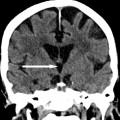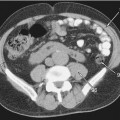Chapter 4
Musculoskeletal Anatomy
 Question 1:
Question 1:
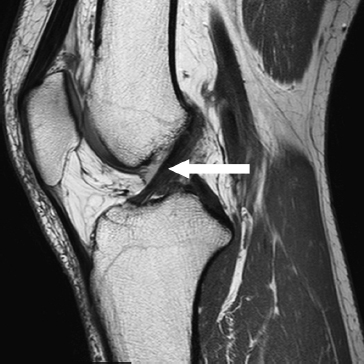
| Name the arrowed structure |
 Question 2:
Question 2:
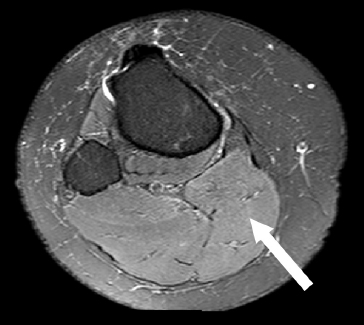
| Name the arrowed structure |
 Question 1: Sagittal MRI of the knee
Question 1: Sagittal MRI of the knee
Answer: Anterior cruciate ligament
• The anterior cruciate ligament extends from the anterior intercondylar notch to the posteromedial aspect of the lateral femoral condyle.
• There are two bands: anteromedial and posterolateral.
• Their main function is to prevent posterior displacement of the tibia on flexion/extension.
• It is seen as a low intensity black band on T1-weighted/proton density MRI.
• However, it may just be the anteromedial band that appears black.
 Question 2: Axial MRI of the right lower leg
Question 2: Axial MRI of the right lower leg
Answer: Medial head of the right gastrocnemius muscle
• The gastrocnemius muscle has two heads: the medial head arises from the medial condyle of the femur and the lateral head originates from the lateral condyle of the femur.
• The soleus and gastrocnemius muscle tendons join together to form the Achilles tendon, which inserts onto the calcaneus. The soleus and gastrocnemius muscles are known as the triceps surae.
• A sesamoid bone known as the fabella is commonly found in the lateral head of the gastrocnemius muscle.
 Question 3:
Question 3:
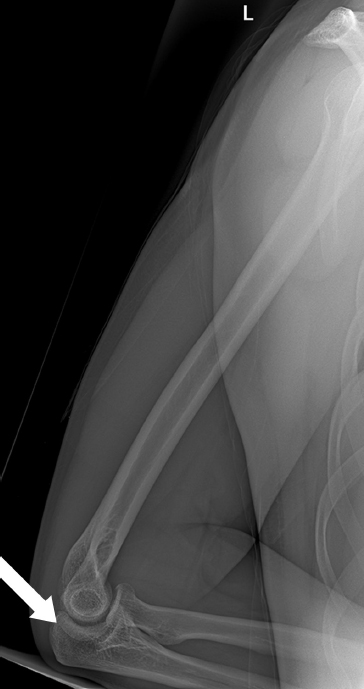
| Name the arrowed structure |
 Question 3: Lateral radiograph of the left elbow
Question 3: Lateral radiograph of the left elbow
Answer: Olecranon process of ulna
• The proximal ulna articulates with the humerus via a hooklike projection with two curved eminences.
• The curved posterior eminence is the olecranon, which fits into the olecranon fossa of the humerus and articulates with the trochlea of the humerus.
• Make sure that you are able to distinguish between the olecranon and the coronoid process, which is the volar eminence of the proximal ulna.
• The triceps brachii muscle inserts onto the olecranon process.
 Question 4:
Question 4:
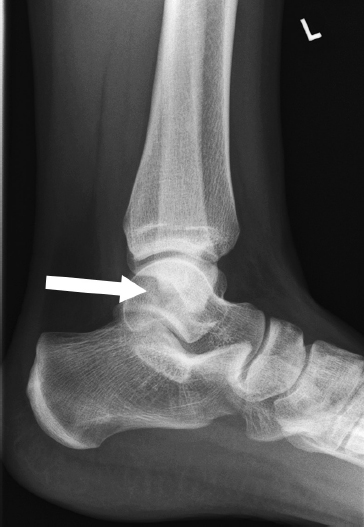
| Name the arrowed structure |
 Question 4: Lateral radiograph of the left ankle
Question 4: Lateral radiograph of the left ankle
Answer: Left talus
• The talus can be divided into three parts: head, neck, and body.
• It articulates with the calcaneus caudally and navicular bone anteriorly.
• The tarsal sinus is a cylindrical cavity between the talus and calcaneus on the lateral aspect of the foot. It runs medially and opens posterior to the sustentaculum tali of the calcaneus.
 Question 5:
Question 5:
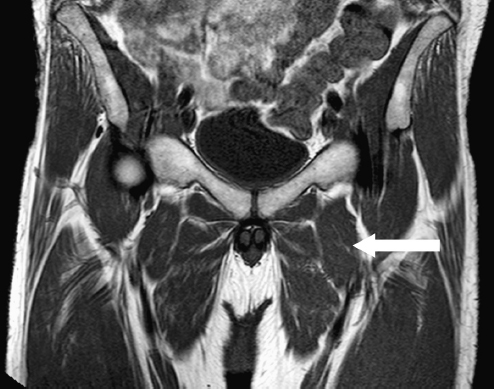
| Name the arrowed structure |
 Question 5: Coronal T1-weighted MRI of the pelvis
Question 5: Coronal T1-weighted MRI of the pelvis
Answer: Left pectineus muscle
• The pectineus muscle adducts, flexes, and assists medial rotation of the thigh.
• It is an anterior muscle that attaches to the superior pubic ramus superiorly and the pectineal line of the femur (beneath the lesser trochanter) inferiorly.
 Question 6:
Question 6:
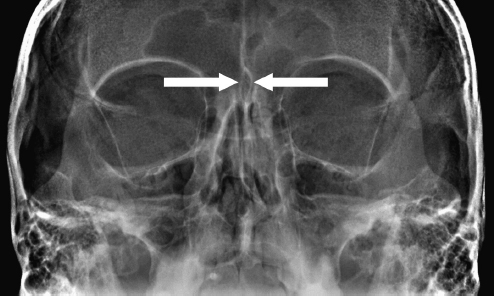
| Name the arrowed structure |
 Question 7:
Question 7:
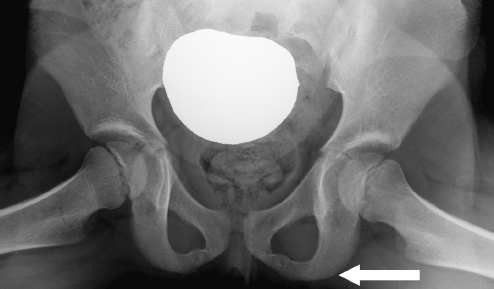
| Name the arrowed structure |
 Question 6: Orbital radiograph
Question 6: Orbital radiograph
Answer: Crista galli
• Crista galli is Latin for ‘crest of the cock’.
• On a frontal radiograph, the crista galli appears as a diamond-shaped bone in the midline at the level of the superior orbits.
• It arises from the cribriform plate of the ethmoid bone.
• It is the anterior attachment for the falx cerebri.
 Question 7: Frogleg lateral hip radiograph
Question 7: Frogleg lateral hip radiograph
Answer: Left ischial tuberosity
• On this radiograph, the ischial tuberosity is seen lateral to the inferior pubic ramus; however, in reality, it is much more posterior.
• The ischial tuberosity is the common attachment for the hamstrings (semimembranosus, semitendinosus, and biceps femoris).
• Note the appropriate use of a gonad shield.
 Question 8:
Question 8:
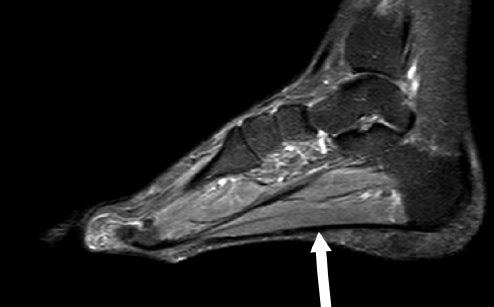
| Name the arrowed structure |
 Question 9:
Question 9:
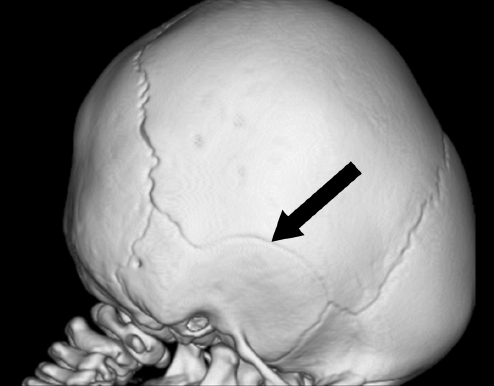
| Name the arrowed structure |
 Question 8: Sagittal MRI of the foot
Question 8: Sagittal MRI of the foot
Answer: Plantar fascia
• The plantar fascia (or plantar aponeurosis) is a strong fibrous layer that connects the calcaneal tuberosity to the heads of the metatarsal bones and supports the arch of the foot.
• It is well delineated on sagittal MRI studies and appears as a uniform hypointense band at the sole of the foot.
 Question 9: Surface rendered 3D reconstruction of a paediatric skull
Question 9: Surface rendered 3D reconstruction of a paediatric skull
Answer: Right temporoparietal (squamosal) suture
• There are three main sutures in the skull: the sagittal suture, the paired lambdoid, and paired coronal sutures.
• Other sutures that may be visible depending on the age of the child are the temporoparietal suture, sphenotemporal suture, and metopic suture.
• The pterion is where the sphenoparietal suture joins the coronal suture.
• The asterion is where the temporoparietal suture joins the lambdoid suture.
 Question 10:
Question 10:
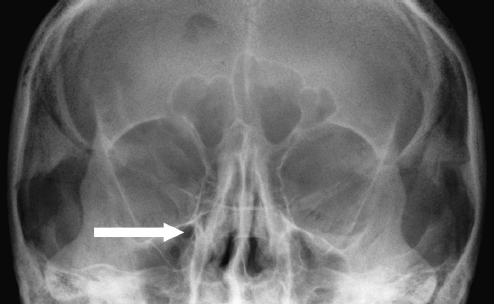
| Name the arrowed structure |
 Question 10: Orbital radiograph
Question 10: Orbital radiograph
Answer: Right foramen rotundum
• The foramen rotundum runs from the middle cranial fossa to the pterygopalatine fossa in the sphenoid bone.
• It transmits the maxillary division of the trigeminal nerve (V2).
• The table below summarises the structures that pass through the skull base and various facial foramina. Questions on this area are common.
| Facial/Skull Foramina | Contents |
| Optic canal | Optic nerve ophthalmic artery |
| Superior orbital fissure | Cranial nerves III, IV, ophthalmic nerve (V1), VI Superior orbital vein, branch of middle meningeal artery |
| Inferior orbital fissure | Infraorbital nerve and artery, inferior ophthalmic veins |
| Foramen rotundum | Maxillary nerve (V2) |
| Foramen ovale | Mandibular nerve (V3), accessory meningeal artery |
| Foramen spinosum | Middle meningeal artery |
| Foramen lacerum | Internal carotid artery |
| Internal auditory meatus | Cranial nerves VII and VIII |
| Jugular foramen | Cranial nerves IX, X and XI, internal jugular vein, inferior petrosal and sigmoid sinuses |
| Hypoglossal canal | Cranial nerve XII |
Middle cranial fossa
Posterior cranial fossa
 Question 11:
Question 11:
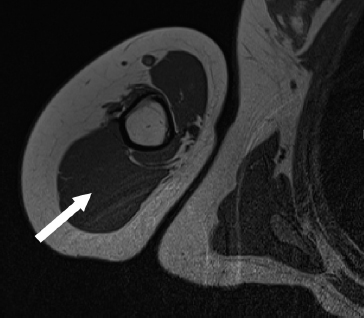
| Name the arrowed structure |
 Question 12:
Question 12:
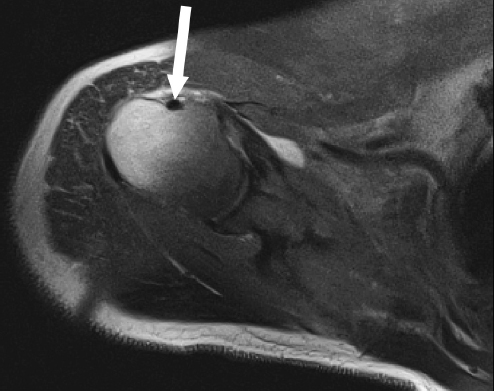
| Name the arrowed structure |
 Question 11: Axial MRI of the upper limb
Question 11: Axial MRI of the upper limb
Answer: Triceps brachii muscle
• As its name infers, the triceps brachii (‘three headed muscle of the arm’) muscle is formed from three proximal muscle bundles (long/lateral/medial heads) that arise from the posterior aspect of the upper limb to join together at the elbow before inserting onto the olecranon process of the ulna.
 Question 12: Axial MRI of the shoulder
Question 12: Axial MRI of the shoulder
Answer: Biceps brachii muscle tendon (long head)
• As its name infers, the biceps brachii (‘two headed muscle of the arm’) muscle is formed by two proximal muscle bundles: the short head originating from the coracoid process of the scapula, and the long head from the supraglenoid tubercle.
• The long head has a tendon that passes within the bicipital groove (intertubercular groove) of the humerus.
• The heads join at mid humeral level to form a common muscle belly before inserting into the radial tuberosity.
 Question 13:
Question 13:
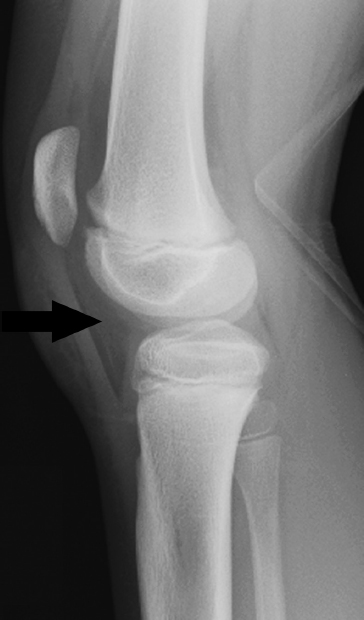
| Name the arrowed structure |
 Question 13: Lateral radiograph of the knee
Question 13: Lateral radiograph of the knee
Answer: Hoffa’s fat pad
• The Hoffa’s fat pad is the fat pad posterior to the patellar tendon and anterior to the knee joint.
• Fat is low density so it appears dark on plain radiography. On both T1- and T2-weighted MRI sequences, fat will appear high intensity (bright).
• A fluid level in the Hoffa’s fat pad or within the suprapatellar recess of the joint is called a lipohaemarthrosis and is a direct sign of an intra-articular fracture.
 Question 14:
Question 14:
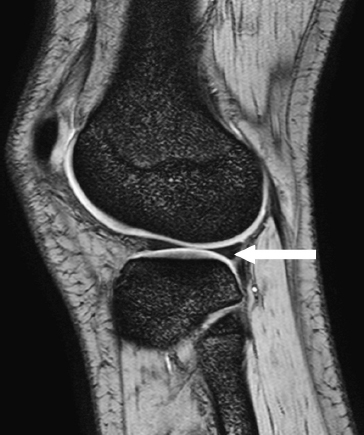
| Name the arrowed structure |
 Question 14: T1-weighted sagittal MRI of the knee
Question 14: T1-weighted sagittal MRI of the knee
Answer: Posterior horn of the lateral meniscus
• The menisci are best seen on sagittal or coronal MRI and appear as black triangles. Degeneration or a tear will usually appear as high (bright) signal.
• It is important that your response to this question be precise. Because the fibula is seen on this slice, you can be sure that this is the lateral meniscus. Determining which is the anterior and posterior horn should be relatively straightforward.
 Question 15:
Question 15:
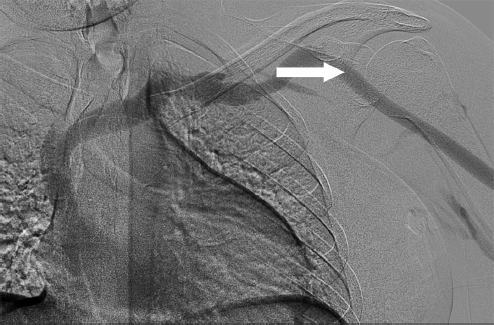
| Name the arrowed structure |
 Question 16:
Question 16:
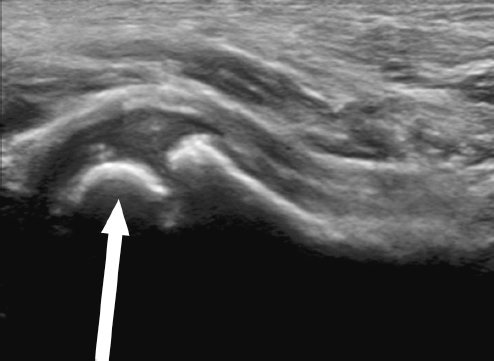
| Name the arrowed structure |
 Question 15: Upper Limb venogram
Question 15: Upper Limb venogram
Answer: Left axillary vein
• The axillary vein forms from the confluence of the brachial, basilic, and cephalic veins.
• It becomes the subclavian vein as it passes underneath the lateral border of the first rib.
• The cephalic vein originates from the confluence of the radial aspect of the dorsal venous plexus of the hand and ascends proximally up the forearm and arm. It pierces the clavipectoral fascia and drains into the axillary vein.
• The basilic vein originates from the confluence of the ulnar aspect of the dorsal venous plexus of the hand and ascends proximally up the forearm and forms the axillary vein.
• The basilic and cephalic veins communicate at the cubital fossa via the median cubital vein.
 Question 16: Ultrasound of an infant’s hip
Question 16: Ultrasound of an infant’s hip
Answer: Femoral head
• Paediatric ultrasound images of the hip are very common in the examination.
• Be familiar with the sagittal view. Orientate yourself with the round femoral head. Visualise the Y-shaped arrangement of the ilium/labrum/acetabular roof, which forms a caplike structure on the femoral head.
• The iliopsoas muscle can be seen as the superficial structure along the axis of imaging.
 Question 17:
Question 17:
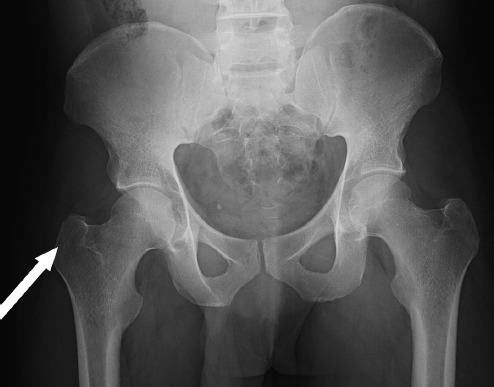
| What muscle attaches here? |
 Question 17: AP radiograph of the pelvis
Question 17: AP radiograph of the pelvis
Answer: Right gluteus medius muscle
• The gluteus medius muscle attaches to the lateral aspect of the greater trochanter.
• The obturator externus and the superior and inferior gemellus muscles attach to the medial aspect of the greater trochanter.
Stay updated, free articles. Join our Telegram channel

Full access? Get Clinical Tree



